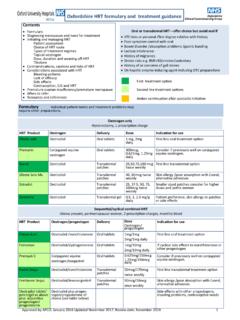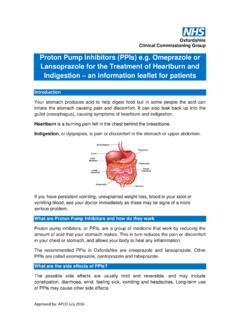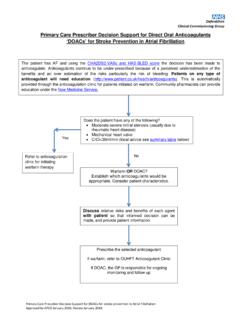Transcription of Investigation and Management of Vaginal Discharge in …
1 oxfordshire Clinical Commissioning Group 1 . Review date Version 5 January 2016. Approved by APCO: Dr Katie Jeffery (Consultant and Clinical Lead Microbiology OUH); Louisa Griffiths (CCG Medicines Management ); Dr David Grimshaw (CCG Pathology lead); Dr Mamatha Oduru (SpR, Genitourinary Medicine OUH); Dr Jackie Sherrard (Consultant, Genitourinary Medicine OUH) SUMMARY POINTS A detailed history, including sexual history, should be taken to explore potential causes and guide Investigation and Management . The commonest causes of altered Discharge are BV and candida. Diagnosis at the first presentation can usually be made using a combination of symptoms and immediate pH testing of Vaginal secretions. A high Vaginal swab (HVS) has limited diagnostic value and should not be used as part of routine first line investigations for Vaginal Discharge .
2 HVS should be reserved for investigating recurrent symptoms, unusual clinical presentations or new symptoms in pregnant women. Whilst Vaginal Discharge is not, in itself, an indication for sexually transmitted infection (STI) testing all symptomatic sexually active women with risk factors for STIs should be offered testing with a triple NAAT (nucleic acid amplification test) for Chlamydia, Gonorrhoea and Trichomonas vaginalis (TV). NAAT testing is the most sensitive and specific method for diagnosing the above three STIs. Women who present to primary care with persistent or recurrent Vaginal /vulval symptoms should be examined and investigated. Chlamydia screening should be offered, annually, to asymptomatic women under the age of 25 ---------------------------------------- ---------------------------------------- ---------------------------------------- ------------------------- OUTLINE AND SCOPE This document provides advice for clinicians working in primary care who will be managing women presenting with Vaginal Discharge .
3 It outlines the main causes of Discharge , Investigation methods and treatment regimes. These guidelines are intended to aid diagnosis and rationalise prescribing. The flow chart summarises the guidelines and is intended for stand-alone use. This guideline updates the previous document (Version Dec 2014). Updates include: Information on a new diagnostic testing procedure for sexually transmitted infection (STI) screening in primary care. A recommendation to diagnose Vaginal Discharge by clinical examination in most cases. New recommendations on the specific indications for use of a HVS. Investigation and Management of Vaginal Discharge in Adult Women oxfordshire Clinical Commissioning Group 2 . Review date Version 5 January 2016. Approved by APCO: Dr Katie Jeffery (Consultant and Clinical Lead Microbiology OUH); Louisa Griffiths (CCG Medicines Management ); Dr David Grimshaw (CCG Pathology lead); Dr Mamatha Oduru (SpR, Genitourinary Medicine OUH); Dr Jackie Sherrard (Consultant, Genitourinary Medicine OUH) Vaginal Discharge Normal physiological Discharge changes with the menstrual cycle.
4 It is thick and sticky for most of the cycle, but becomes clearer, wetter, and stretchy for a short period around the time of ovulation. These changes do not occur in women using oral contraceptives1. The vagina is colonised with commensal bacteria (normal Vaginal flora including lactobacilli) and the environment is normally acidic (pH < ). Only the patient can be aware of her own normal amount and type of Discharge . The normal Discharge may increase: Premenstrually At time of ovulation When commenced on HRT or hormonal contraception Pregnancy CAUSES OF ABNORMAL Vaginal Discharge Abnormal Vaginal Discharge is characterized by a change of colour, consistency, volume, or odour, and may be associated with symptoms such as itch, soreness, dysuria, pelvic pain, or intermenstrual or post-coital bleeding1.
5 It is most commonly caused by infection; less commonly, abnormal Vaginal Discharge can have a non-infective cause1. Table 1: Causes of altered Vaginal Discharge in women of reproductive age2 Infective (non-sexually transmitted) Infective (sexually transmitted) Non-infective Candida Chlamydia trachomatis Foreign bodies (retained tampons, condoms, etc) Bacterial vaginosis (BV) Neisseria gonorrhoea Cervical polyps and ectopy Trichomonas vaginalis (TV) Genital tract malignancy Herpes simplex virus Fistulae Allergic reactions and genital dermatoses oxfordshire Clinical Commissioning Group 3 . Review date Version 5 January 2016. Approved by APCO: Dr Katie Jeffery (Consultant and Clinical Lead Microbiology OUH); Louisa Griffiths (CCG Medicines Management ); Dr David Grimshaw (CCG Pathology lead); Dr Mamatha Oduru (SpR, Genitourinary Medicine OUH); Dr Jackie Sherrard (Consultant, Genitourinary Medicine OUH) NON-SEXUALLY TRANSMITTED INFECTIONS Candida 2 Vulvo- Vaginal candidiasis is caused by overgrowth of yeasts, predominantly Candida albicans (70-90% of cases) and non-albicans species (mainly Candida glabrata) in the remainder.
6 Candida thrives in oestrogenised environments thus is more common during the reproductive years and during pregnancy. It is more common in patients with background immunosuppression ( Diabetes mellitus, steroid therapy, HIV, chemotherapy etc) or after a patient has received a recent antibiotic course. Candida is commonly found in individuals who are not sexually active. Bacterial vaginosis 2, 3 BV is the most common cause of abnormal Discharge in women of childbearing age. It may be asymptomatic or may exhibit classical clinical symptoms and signs (see table 2).The Vaginal flora is dominated by many anaerobic and facultative anaerobic bacteria; concentrations may be up to a thousand-fold greater than normal. This overgrowth of anaerobic bacteria leads to an increase in Vaginal pH.
7 In BV, the pH of Vaginal fluid is elevated above and may be up to There is a growing body of evidence suggesting that BV may be more common in women who are sexually active; thus it is considered sexually associated rather than sexually transmitted . SEXUALLY TRANSMITTED INFECTIONS Chlamydia trachomatis 2, 4 Chlamydia is caused by the obligate intracellular bacteria Chlamydia trachomatis. It is the most commonly reported curable bacterial STI in the UK, with approximately 70% of infections in people aged 16-25. The majority of cases in men and women are asymptomatic. However women may present with abnormal Discharge due to cervicitis plus abnormal bleeding (postcoital or intermenstrual), dysuria or symptoms of pelvic inflammatory disease.
8 Neisseria Gonorrhoea 5 Gonorrhoea is caused by a Gram negative intracellular diplococci, Neisseria gonorrhoea. Up to 50% of women are asymptomatic but some may present with abnormal Vaginal Discharge , pelvic pain or dysuria. oxfordshire Clinical Commissioning Group 4 . Review date Version 5 January 2016. Approved by APCO: Dr Katie Jeffery (Consultant and Clinical Lead Microbiology OUH); Louisa Griffiths (CCG Medicines Management ); Dr David Grimshaw (CCG Pathology lead); Dr Mamatha Oduru (SpR, Genitourinary Medicine OUH); Dr Jackie Sherrard (Consultant, Genitourinary Medicine OUH) Trichomonas vaginalis 6 Trichomonas vaginalis is a flagellated protozoan which is sexually transmitted. The organism is found in the vagina, urethra and paraurethral glands.
9 10-50% of women may be asymptomatic and the remainder may present with abnormal Discharge , vulvitis and malodour (see table 2) Herpes simplex virus 7 Herpes simplex virus (HSV) types 1 and 2 usually present with external genital ulceration. Occasionally, ulceration of the cervix may cause abnormal and increased Vaginal Discharge . This may occur in the absence of genital lesions. NON-INFECTIVE CAUSES A retained foreign body such as a tampon, condom, or Vaginal sponge. Cervical ectopy or polyps Tumours of the vulva, vagina, cervix, and endometrium Atrophic vaginitis in post-menopausal women. Inflammation due to allergy or irritation caused by substances such as deodorants, lubricants, and disinfectants. Table 2: Clinical features associated with the three most common causes of Vaginal Discharge during the reproductive years8 Feature Vulvovaginal candidiasis Bacterial vaginosis Trichomoniasis Symptoms Thick white Discharge Thin Discharge Scanty to profuse or frothy yellow Discharge Non-offensive odour Offensive or fishy odour Offensive odour Vulval itch Superficial dyspareunia Dysuria No discomfort or itch Vulval itch or soreness Dysuria Low abdominal pain Dyspareunia Signs Vulval erythema, oedema, fissuring.
10 Satellite lesions Discharge coating vagina and vestibule No inflammation of vulva Vulvitis and vaginitis 'Strawberry' cervix pH of Vaginal fluid Vaginal pH < Vaginal pH > Vaginal pH > Microscopy Yeasts and pseudo-hyphae Clue cells oxfordshire Clinical Commissioning Group 5 . Review date Version 5 January 2016. Approved by APCO: Dr Katie Jeffery (Consultant and Clinical Lead Microbiology OUH); Louisa Griffiths (CCG Medicines Management ); Dr David Grimshaw (CCG Pathology lead); Dr Mamatha Oduru (SpR, Genitourinary Medicine OUH); Dr Jackie Sherrard (Consultant, Genitourinary Medicine OUH) Management OF WOMEN PRESENTING WITH Vaginal Discharge Medical and sexual history It is paramount to take a history to ascertain the underlying cause of the altered Vaginal Discharge .














